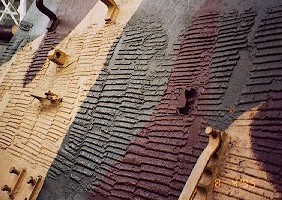1⁄35Zimmerit: History and How-to
I do not think there is another word in model building that causes as much fear as "Zimmerit" does for modelers of WW2 German armour. Lets face it, no matter which method is used, it is seems difficult to pull off a good Zimmerit job. There have been several new and innovative products introduced over the past few years to make this job a little less troublesome. But first a little history may alleviate some of this fear.
Zimmerit History
Zimmerit was first made available during the summer of 1943 as a counter to magnetic and adhesive anti-tank mines. The British had an adhesive "sticky bomb" for this purpose, and the Germans had lost several panzers to it during the attacks on France and the Low Countries, Greece and North Africa. The Soviets may have received these sticky bombs from Britain as part of the Lend-Lease agreements. In addition, the Germans' themselves had a shaped charge magnetic AT mine and it was a common German practise to develop a counter to weapons which they themselves possessed.
Most popular modelling literature has stated that zimmerit was a plaster or concrete, however this is not correct, according to a British war-time report, "'Zimmerit', Anti-Magnetic Plaster for AFVs", (reported by Major J.W. Thompson and Mr. C.E. Hollis, July 1945). In fact, zimmerit was a mixture of polyvinyl acetate, 25%, which formed the matrix, 10% saw dust used as a filler. Additionally Zimmerit included 40% barium sulphate and 10% zinc sulphide in the mix, but the report did not state why. Its dark yellow colour was achieved with the addition of 15% ochre pigment. Zimmerit was developed in Berlin by the C.W. Zimmer Company, (this was where Zimmerit got its name), it was ready for use in the summer of 1943.
 |
Ridged Pattern on a Jagdtiger |
Production zimmerit was applied only to an AFV's vertical surfaces, and the protection gained was twofold: first, it created a rough surface and consequently reduced the area of contact - this defeated the "sticky bombs"; second, it put distance between the hull and the mine - this defeated magnetic mines. It is important to note that zimmerit possessed no "anti-magnetic" properties of its own, rather it defeated the mines in the previous manners. In mid 1944, however, the application of zimmerit was phased out due to its being rendered obsolete by greatly improved AT weapons. It is interesting and worth noting, that the British were looking into the use of captured stocks of zimmerit for their AFVs in the Pacific, however the war against the Japanese ended before this plan could be implemented.
©2002 Paul A. Owen and Track Link - All Rights Reserved. Reprinted with permission.








